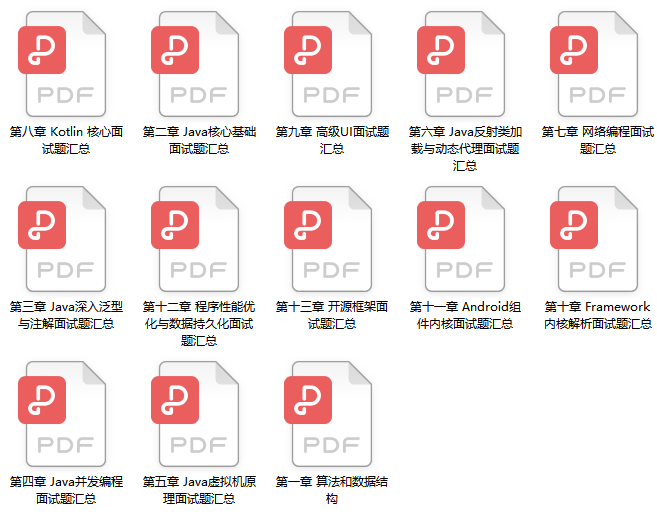foreword

Careful friends may see that one of the knowledge points that major Internet companies must ask today is Framework, but many people do not know the underlying principles of Framework. If you want to become a senior Android developer, you must be proficient in the underlying source code of the Framework!
The importance of Framework and Binder in the interview
Framework
Usually, as an Android APP developer, we don't care about the source code implementation of Android, but with more and more Android developers, companies are more and more interested in a programmer's understanding of the underlying Android and Thinking , the bottom layer here is mainly the operating principle of each component in Android Framewok, such as the operating mechanism of Binder, the role of ServiceManager, and so on.
In the Android interview, questions about the Framework are necessary, but have you mastered these high-frequency interview questions about the Bytedance Framework?
Knowledge points of Framework questions frequently asked by Byte interviewers:
1.AMS, PMS 2.Activity startup process, App startup process 3.Binder mechanism (IPC, AIDL usage) 4.Why use Parcelable and what are the benefits? 5. Android image display related process, Vsync signal, etc.
Binder
The apps of first-tier enterprises are all multi-threaded and multi-process, while the Android inter-process communication mechanism is Binder, and the native inter-thread communication is Handler . Knowledge points that must be asked in corporate interviews!
The following are the real interview questions commonly asked by Dachang about Binder:
- What are the advantages of Binder? (Byte Beat)
- How does Binder make a copy? (Tencent)
- Explanation of the principle of MMAP; (Tencent)
- Why can't Intent pass big data? (Ali)
- Describe the details of the java class generated by AIDL; (ByteDance)
- The underlying communication mechanism of the four major components; (Byte Beat)
- Why can't Intent pass big data? (Ali)
- How does the Binder mechanism work across processes?
- Binder mechanism principle
- …
In order to let everyone better grasp the principles of Framework and Binder, today I will share a summary of Android Framework high-frequency interview questions and BATJ Daniel Notes Android Framework kernel analysis . After reading it, I don’t believe you still don’t master Framework and Binder.
The full version of the document has been organized and packaged, partners who need it can scan the QR code below + v for private chat~

↓↓↓【Preview】↓↓↓

Analysis of Android Framework high-frequency interview questions
1. AMS 、PMS
- AMS overview
- AMS start-up process
- AMS and Process Initiation
- AMS family
- PMS

2. Activity startup process, App startup process
- Activity's launch mode
- What is the Zygote process
- The startup process of the Zygote process
- SystemServer process startup process
- start service

3. Binder mechanism (use of IPC, AIDL)
- What is AIDL and how to use it
- What is the full name of AIDL? How does it work? What types of data can it handle?
- Android's IPC communication method, what are the thread (inter-process) communication mechanisms

4. Why use Parcelable and what are the benefits?
- Implementation Mechanism

5. Android image display related process, Vsync signal, etc.
- Analysis of Android Vsync Principle
- double buffering
- triple buffering

BATJ Daniel Notes Android Framework Kernel Analysis
Table of contents

Part of the content of the chapter is displayed:
The boss of BATJ is an expert in this field. The information he compiled has a total of 452 pages. It is the result of his work based on his actual work experience and analysis of the Android Framework kernel. The information is very popular. The whole network, but now open for download!
The content of the article is relatively long, and one article cannot be finished. In order not to affect your reading experience, the following will only display part of the content in the form of screenshots.
You can see if there are any points that you need or are interested in, so as to check for gaps in your knowledge system.
The first section of the Binder series - the beginning
I. Overview
2. Binder
3. Outline
4. Source directory

Section 2 Binder Driver Preliminary Study
1. Binder driver overview
Two, Binder core method
3. Appendix

The third section Binder Driver revisit
1. Brief description of Binder communication
Two, Binder communication protocol
3. Scenario summary
Four, Binder memory mechanism

The fourth section Binder starts ServiceManager
I. Overview
2. Startup process
3. Core work
4. Summary

Section 5 Get ServiceManager
I. Overview
2. Get the ProcessState object
3. Get the BpBinder object
4. Get BpServiceManager
V. Summary

Android Framework refined kernel analysis preview
Section 6 Registration Service (addService)
Section 7 Get Service (getService)
Section 8 framework layer analysis
Section 9 How to use Binder
Section 10 How to use AIDL
Section 11 Binder Summary
Section 12 Full Analysis of Binder Interview Questions


